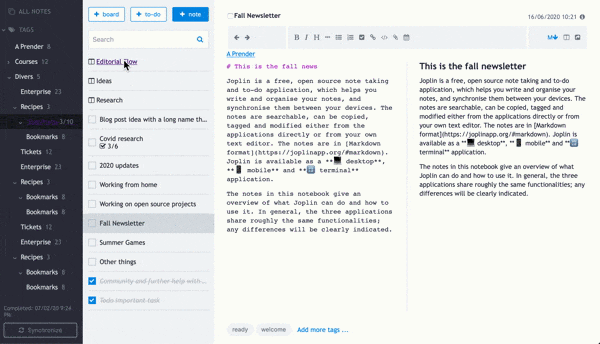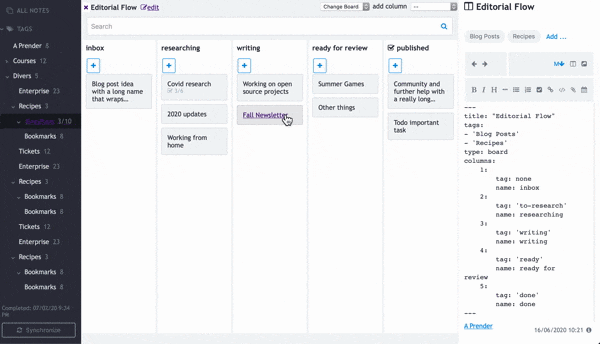I keep posting about a Kanban idea, so I thought I’d flesh it out a little further. Seems like this will be better as a Plugin, so I will wait for that, but thought maybe I could get some feedback in the meantime.
Caveats: I roughly used the new styles for this, but in no way is this attempting to show finalized design. Just wanted to rough out the concept. Sorry for the terrible GIF quality!
Boards

The way I envision this is that there is a new type of markdown file (like a note or to-do) called a board. These would appear in the normal note list, and clicking them would open them as a board.
Each column in the board is a tag.
When it first opens, you can see that a board file is defined in yaml like traditional markdown. You can define which tag is which column, and give them an easier to read name (ready --> Ready to Review)
YAML example
---
title: "Editorial Flow"
tags:
- 'Blog Posts'
- 'Recipes'
type: board
columns:
1:
tag: none // this is none, so that it picks up any thing tagged "Blog Post" that doesn't have another column defined, an easy way to pickup new notes.
name: inbox
2:
tag: 'to-research'
name: researching
3:
tag: 'writing'
name: writing
4:
tag: 'ready'
name: ready for review
5:
tag: 'done'
name: done
---
In this example, I am in the tag “Blog Posts” viewing the board “Editorial Flow”.
Notes

You can view and edit notes like normal in the right panel, just by clicking on them. You could drag the column to change the width, just like normal.
The fancy part is that dragging a note between columns automatically updates the tag.
In this example, the note “Fall Newsletter” had the tag “writing” and when I moved it, that was replaced with “ready”.
Misc
- Since columns are tags, when you add a column, you see a list of all the tags in use across the current notes and can add new ones.
- Since boards are just a special type of file to look at other notes, you can have many boards for the same set of notes. Think a GTD, story maps, roadmap planning etc.
- Also, you can reuse them across different tags, just by tagging the board to another collection. In this example, my Editorial Flow is tagged with “Blog Posts” and “Recipes”


